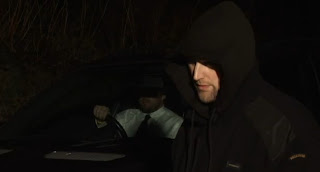We worked with the set we had in our prelim but in this task we had to create a convincing set all from scratch. Our thriller was only as good as we decided to make it, and the more effort we put in, the more we would get out of it. In our prelim we had teachers to remind us of the lighting, tripod and camera shots. However in this thriller opening sequence, we were completely left to do it ourselves. I was happy about this as we were given a lot of responsibity and although we made certain mistakes, we could learn from our mistakes and had to find ways to work them out together as a team.
It taught me how to deal with things when faced with problems, and really brought our group together as we discovered each others strenght and used each other to our advantages.
The planning in our preliminary task was more rushed and with minimum detail because it was such a short clip. I adapted my basic media skills in development, which was a key advantage for later on with my thriller. In the plan, we had a pre-set storyboard and a set location and chosen actors all prepared so our main focus would be on editing. As key adjustments were required due to dialogue, which was not required in our thriller. We did use a variety of different angles in the prelim to created different effects in status and strength for the characters. This was useful in adaptation of my thriller later on. The use of sound in the prelim was only vocal, we were unaware of dealing with non-diegetic sounds like music, which we did tackle in our thriller, using background noises acquired from a online system which we them input to our thrillers to added more detail in the location, and the correct atmosphere of mystery. Our preliminary task was also useful in developing our understanding of FinalCut Pro, which was vital for larger projects like our thriller sequence. No extra lighting was required here other than the set lights of the location.
In my Thriller our planning sequence was much more details and thought out across a longer period of time, with actually preparation of props and set not occurring until our shoot day. With planning of our thriller, we had to prepare our storyboard so to have a basic structure of filming with we needed to accomplish. We also had to devise a location and acquire extras such as, cardboard and costumes. There was also key development in skills of media, with non-diegetic sounds, adding text into the clip sequence and cross-fading. Our use of camera work was larger than previous use in our prelim, using cross-cutting between the main character and the businessman symbolising the status and setting up an idealistic sense of sympathy from the viewers. Key editing extras included shot reverse shot and match on action to create tense moments due to the lack of vocal sound in my thriller. Because our thriller was set at night, we required overhead lighting, which added to the idea of the setting as an industrial compound with nightlights, as well as light from the car. As shown in the images below, the left clip shows that the main light source is above, from the ceiling, as well as behind the camera, while in the right clip, the setting is at night and because of it we used two large 850 watt redheads to cast a glow across the set so to make key details stand out, like the dark figure waiting beside the vehicle. Key sound development for me was learning to adapt the background noises, using sound effects, as well as blocking out useless extras like my directory points.
With my own personal work on our thriller, my key development was in adaptation and skills using SoundTrack Pro. Key moments throughout our thriller sequence required background non-diegtic sounds to aid in the correct atmosphere we wanted in our thriller. Some vital examples was the ambient generator noise we faded into the background, to hold the illusion of our setting in a industrial compound. Another crucial sound effect was a rising echo and vibrating effect when the girl is revealed in container, creating tension and fear from the audience in the sudden understanding of the plot behind this thriller. As well as sound, the editing development was an improvement to my previous media work. In the prelim we used simple cuts from one shot to the next, in contrast to our thriller where he expanded our choices, using match on action and close-ups on key movements, like the opening of the container.
The use of Camera Work was increasingly more developed on my thriller sequence in comparison to my prelim. One vital camera moment was a set of snap shots between the girl in the container as shown below, and the figure by the car, slowly getting in closer and closer into an extreme close-up. We chose this because it sets up the levels of status, reflecting on the dark figures power over the poor innocent girl in the container.
We also acquire feed-back from fellow media students who had watched our thriller, obtaining, positive and negative comments which helped in showing how well we designed our thriller, and how we could’ve improved it.




No comments:
Post a Comment